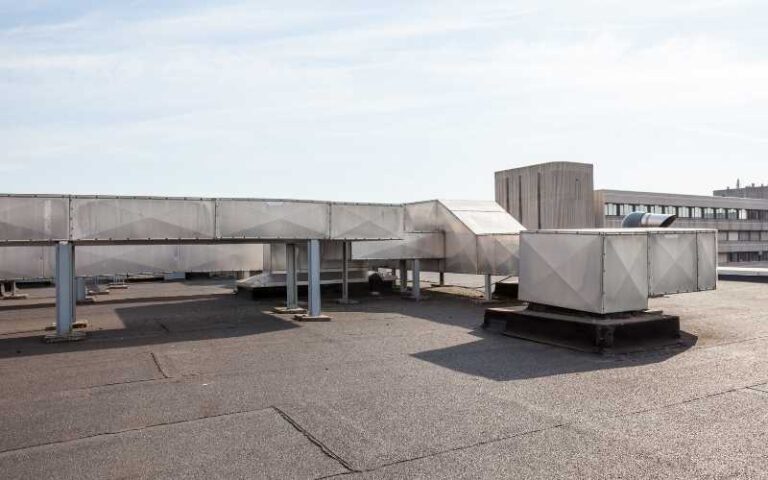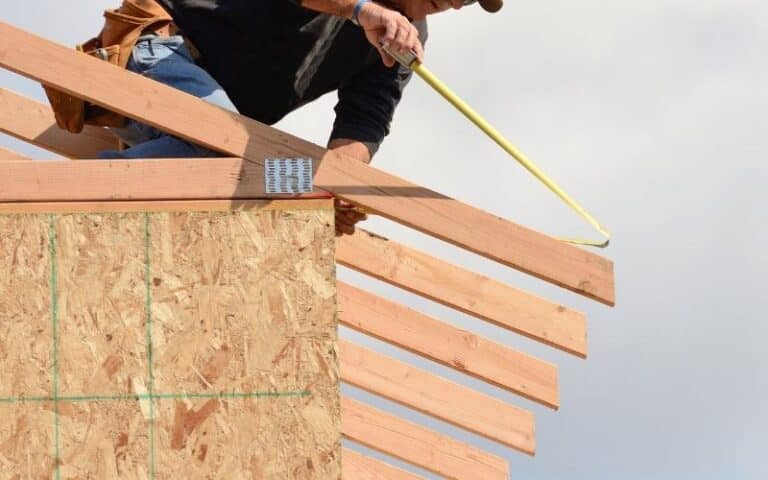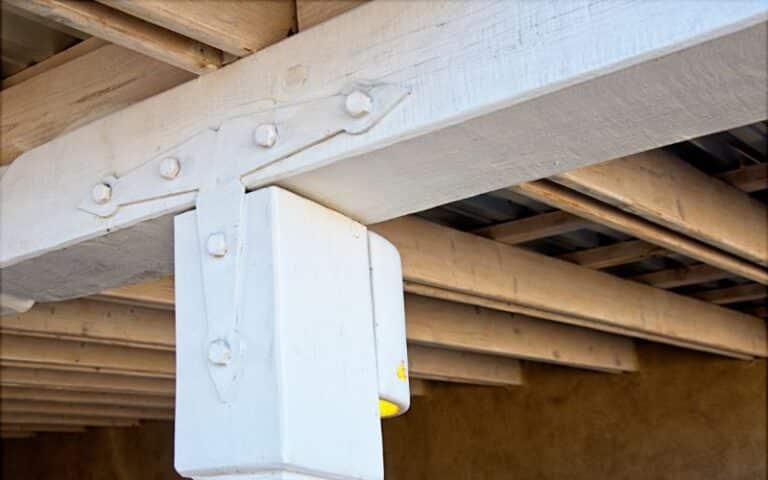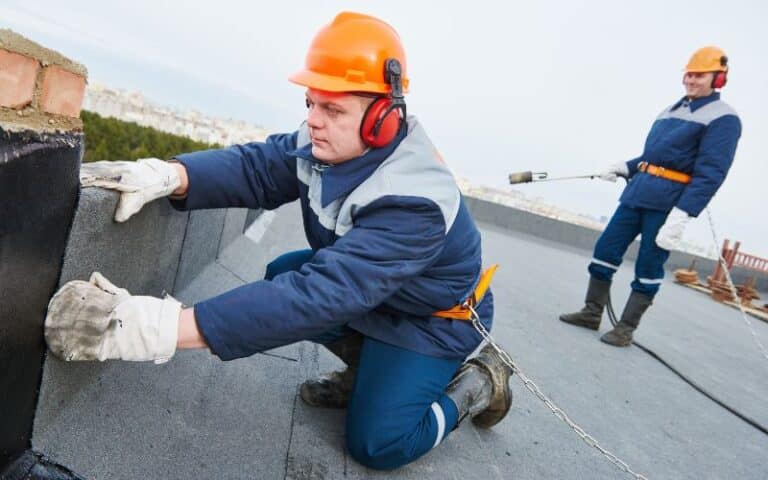It is not possible to work on the roofs without walking on them when installing roofs. While you can walk on some roofs, you cannot walk on others.
This entirely depends on the strength. So, you may be wondering if you can walk on steep roofs such as 45 degrees angle roofs.
Walking on steep slope roofs requires extreme caution. Fortunately, there are a couple of safety measures to enhance safe roof walk. They are as essential as wearing rubber-soled footwear, and harnesses, thoroughly inspecting roofs to remove any material capable of causing injury, and working only in favorable weather conditions since you inevitably walk on the roof while working.
Ready for a Roofing Quiz?
Can You Walk On A 45-Degree Roof?

Of course, you can walk on a steep slope roof. However, care and caution are required for this due to its delicateness which may sometimes make you wonder if it is safe to roof walk.
After all, these preventive measures are not complicated but easy to implement.
All you need to do is follow these steps:
- Wear rubber-soled shoes or boots to enhance traction. These shoes make traction easier than flat shoes, especially when climbing steep roofs. No matter how dry the roof may seem, ensure to wear rubber shoes or boots.
- The majority of experienced roofers recommend walking sideways on the roof when you walk on steep roofs.
- Ensure to wear a harness as these enhance the girth and support your body. It also gives you better control over your body as you take each step on the roof.
- While you walk on the roof, make sure to keep your legs tightly together as you make a move and walk sideways.
Is A 45 Degree Roof Too Steep?
No, a 45-degree roof has just the right angle pitch roof. The pitch angle is almost always 2 inches with a 20 feet height, bringing it to an estimated area of 4000 square feet.
A steep roof has significant advantages, such as; less danger of harboring condensed or stagnant water; it also prevents ice build-up and cooling bills in much warmer areas. Steep roofs also help roofers lookout for danger or warning signs more effectively.
Most steep roof pitches have attic spaces for occasional or continuous storage. In addition, leaves, dirt, and dust tend to stay off steep roofs due to their high angle.
As a result, steeper roofs are much more durable and last longer than any kind of roof. This is so because they are often free from dust, dirt, debris, ice, and stagnant water.
How To Climb A 45 Degree Roof
Most roof climbers see roof climbing as necessary for roof maintenance and construction.
However, especially for a 45-degree roof with a steep slope, the knowledgeable use of appropriate tools, safety measures, and technical know-how is required before you climb the roof.
The tools required include; a ladder, gloves, rubber-soled shoes or boots, rope, Carabiners, harness, and an anchor trolley system.
#1. Ladder
The ladder is used for a sturdy extension and is placed at least 3 feet in the ground.
#2. Rubber-soled boots and shoes
Rubber-soled boots make traction easier and are safer. It also expands and stretches out to hold the roofing shingles to the shoes, preventing you from slipping down.
No matter how dry your roof may be, you stand at a safer end if you wear rubber shoes. Flip flops and flat shoes are never to be used.
However, the boots used ought to have a soft sole.
#3. Carabiners
Carabiners are mostly attached to ropes and roof safety harnesses while climbing the roof. It enables sturdiness and stability.
A Step By Step Guide On How To Climb A 45 Degree Roof
Eight crucial steps must be followed while climbing the roof. Do this to enhance safe shelter walking on the steep roof and avoid causing damage to your roof.
#1. Check The Anchor System
Always endeavor to check the anchor trolley system. Make sure it is firmly rooted to the ground. It should be attached to a solid material of at least ¾ inch to hold it in place.
The solid materials used should weigh hundreds and thousands of pounds such that the anchor is not loose.
#2. Do All You Can To Prevent Falling Or Slipping
You have to get the appropriate footwear when climbing roofs. Most professionals recommend that you use boots. While this is one way to prevent a fall, another way is to have sound footing.
A strong material of at least a quarter-inch should be placed between your foot and the shingle. For easy navigation on the roof, you can remove a nail or piece of shingle to have a good purchase as you walk.
This may, however, be dangerous if the roof is opened, broken, or loose.
#3. Start Off Practicing With A Low Slope Roof
A 45-degree roof is one of the most complicated roofs to climb on. Therefore, it is recommended that before you go off climbing much steeper roofs, you can start to practice with a low slope roof like a 30-degree angle roof.
This exercise invariably deals with any kind of fear or height anxiety.
#4. Separate Your Hands And Feet As You Practice Climbing
You need to start testing your grip and firmness by keeping your hands apart from your legs while you bend and allowing them to touch different roof parts as you take each step over the other.
Next, you should try walking freely apart from the roof with your hands and legs.
#5. Go Ahead And Make A Move
Locate handholds and footholds that you know can handle your body weight even if you stand at a fixed point. You can hold onto something else, too, if you feel these footholds or handholds are not strong enough.
For a 45-degree roof with a steep roof, climbing it higher may become less secure and take you far from the anchor roof system.
If you have reached this point, climb down and restart the whole climbing process, especially if you have not encountered any challenges.
#6. Locate Solid Grips
Compressed roof shingles make climbing the roof easy and make solid grips. However, as you climb the roof, you may stumble or slip, so you should hold onto only firm grips and be observant if it suddenly becomes loose to switch over to another firm grip quickly.
It is also easier to simply create at least a quarter-inch space between your legs and the roof underneath them to enable you to keep track of where you are headed as you climb the roof.
#7. Cover Up The Spaces Underneath Your Legs
As you advance upward on the roof, the spaces you have left behind will continue to increase and grow longer. If you slip or trip, you may fall onto the ground.
Therefore, as you get conversant with the height and angle on the roof, cover up the spaces with a shingle or flat board.
#8. Don’t Stop Climbing
As you climb the roof, leave your hands and feet apart as you carefully take each step. Do this repeatedly to gain mastery and stability on the roof.
Related: 70 Degree Roof Pitch (Beginners Guide)
What Angle Roof Is Safe To Walk On?
The most common slopes are expressed in angles and grades. Their walkability is dependent on the roof slope angle.
All roofs with angles ranging from 0° to 26.7° are easy to walk on. They are primarily low steep roofs or flat roofs. Even 30-degree roof angles are walkable, but caution is in place.
Extreme caution is recommended when walking on steep roof slopes ranging from 42.51° to 90°. Most times require the use of harnesses, ropes, and ladders.
Conclusion
This article talked about how to walk on a 45-degree roof, and climb it, the safety procedures used in climbing, and how to gain mastery of roof climbing. Furthermore, we highlighted the various tools used in roof climbing.
Finally, we discussed the suitable angle roofs that are safe to be walked on.











